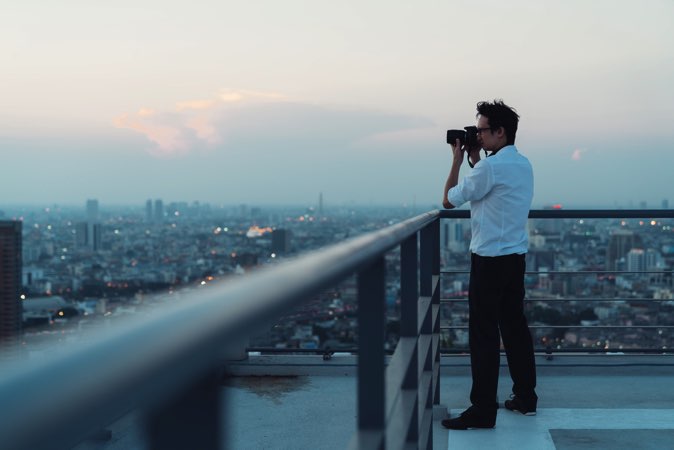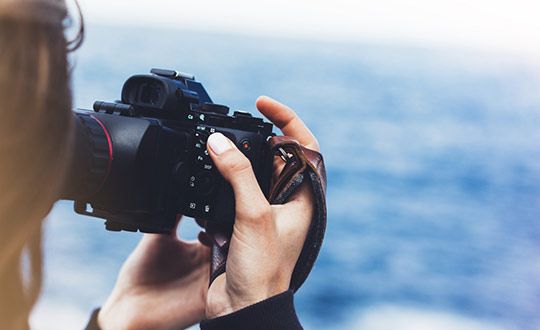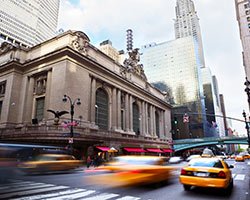If you’re interested in becoming a professional photographer, there are several crucial topics worth exploring before you dive in. From educational options and industry certifications to mastering the marketing essentials necessary to starting a business, there is a ton of knowledge available that all aspiring photographers should take the time to uncover before getting started. To begin your research, below we’ve outlined some answers to a few of the most common and important questions we’re asked by aspiring professional photographers:
What Do Photographers Do?
A photographer is an artistic professional specializing in the art of taking photographs with a digital or film camera to be used and sold for a variety of purposes. Photographers are experts in the manipulation of both artificial and natural lighting in an effort to capture meaningful photos of countless people, places and things- and in a variety of settings. While many photographers focus primarily on studio work, others specialize in landscape, others in photojournalism and news, and others in commercial, advertising-oriented photography, just to name a few.
While a large percentage of photographers work as freelancers hired for specific, variously-timed jobs by numerous clients in lieu of traditional 9-5 office hours, that’s not necessarily the case for every professional. Some photographers do elect to work exclusively in certain segments of the industry that lend themselves to a full-time dynamic, in office employment such as corporate or full-time studio work. Additionally, a large number of professionally trained photographers focus more on the artistic nature of the industry, shooting more imaginative, abstract works to be sold on an individual basis to art collectors or independent buyers.
What do photographers do on a normal workday?
Do I Need a Photography Degree?
If you’re interested in launching a successful photography career, it’s important to consider which educational options are considered industry standard. Unlike other professions, the presence or lack thereof when it comes to a university degree is something of debated importance amongst photographers today. While many other specialists are literally unable to get hired and start working as, say, a nurse or lawyer without the proper credentials, that’s simply not the case when it comes to photography. Thousands of photographers currently running successful businesses today never went to college for their craft. Some are self-taught, some took courses locally at a community college or arts center, some learned online. Essentially, wanting or needing a photography degree is a personal question in this industry more than a logistical or legal one. Do you know how to use a digital camera? Do you understand compositional concepts like aperture, ISO, exposure, etc.? Do you know what all the dials and functions on your camera are capable of and when and where to best use them? What about the business aspect of your career- are you familiar with marketing or how to draft a yearly business plan? Do you know how to find and sign clients? These are all things someone with a successful photography business must know, but not things necessarily only learned via an expensive, 4 year long university bachelor’s degree program.
If you’re unsure which educational route is best-suited for your needs, we’ve developed a simple chart you can reference as you move forward with your decision making process. See side by side how much money you’ll pay for different options and exactly the quality of comprehensive education you’ll get for that cost. Determine which gaps in your business and photography knowledge need to be filled before you get started and pursue the appropriate resources accordingly.
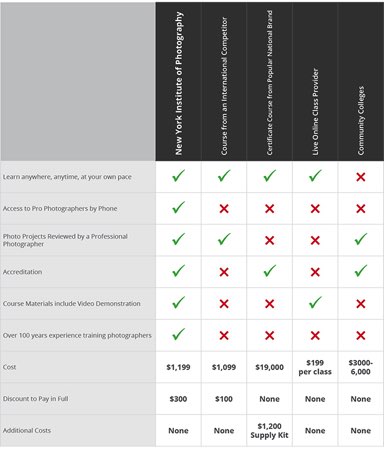
Do you need a photography degree in order to start a business?
Can I Get Certified in Photography?
Similar to the presence of a university degree, this is also something often debated amongst photographers in today’s industry, and is more of a personal professional decision more than a requirement. Undoubtedly, certification is a seamless way to give potential clients peace of mind. For some, it’s seen as a way to legitimize a business and gain trust within your market. For example, although your next potential consumers, a couple looking to book a wedding photographer, might not personally know much about professional photography, they do understand that any industry standard certification suggests professional-quality goods and services. While anyone can technically buy a camera, teach themselves how to use it and find clients, your buyers will have confidence in knowing that not just anyone can get certified by a national photography organization.
That being said, there are plenty of photographers working today with no certifications on their resume. If you’re an expert when it comes to networking and don’t feel hesitant about pitching your photos and skills to clients without some solid reference, by no means is that certification something you’re legally required to have. If it makes you feel comfortable to tell customers that you’re certified, it might be a route worth considering.
When it comes to NYIP student certification, our students are specifically recommended to pursue the Professional Photographers of America (PPA). They are the world's largest non-profit photography association organized for professional photographers, by professional photographers. Today, they have a membership of over 29,000 in more than 50 countries. For our students, the CPP certification program can be added to any photography course at the time of enrollment for $473. For non-students of ours, note that this cost is $50 less than the price typically offered by PPA and includes one year of PPA membership. After purchasing, the path to certification is a pretty straightforward process broken out into three general steps. First, students will go through a simple process of declaring their candidacy to PPA. After that, they will be required to study for and subsequently pass the CPP exam. After passing said exam, candidates are then required to submit a series of images for official review. Once those submitted images have been approved, that photographer will have earned their CPP designation.

Are photography certifications really necessary?
Do Photographers Need To Complete Internships?
Unlike other professions that require employees to complete some sort of mandated training program, internship or residency, photography is a different line of work in that these experiences are surely extremely helpful but are not necessarily requirements. However, when it comes to the industry standards, there are a few different routes one can take as a beginner looking to gain experience on a more intermediate or amateur level before declaring professionalism and diving in as an independent artist.
One common internship-like method is to collaborate with local vendors in what is often referred to as “test shooting.” Let’s say for example that you’re hoping to one day start your own independent wedding photography firm, but you’ve only just finished some formal educational training, have yet to work with clients on any paid gigs and are looking to get a little experience under your belt before you agree to work someone’s wedding. Consider the fact that many local florists, invitation designers and bakeries are always in need of fresh images to use for their own social media or promotional purposes, especially if said vendors are also new to the industry. What many amateur photographers pursue in place of an internship is a “test shoot” with said vendors, in which the photographer shoots their products- providing the vendor with nice product shots and the aspiring professional with some relevant, professional-looking images that can be used in a legitimate wedding portfolio. It’s also worth mentioning that by establishing a professional relationship such as the aforementioned, amateur photographers are making crucial networking connections with exactly the kind of business owners who can point said photographers in the direction of new clients.
Another internship-like option for aspiring photographers is to pursue work as what photographers call a “second shooter.” A second shooter essentially accompanies an established professional photographer on his or her gigs. If this is something you’d like to try, start out by contacting some local photographers whose work you admire and hope to learn from. Send said photographer a pitch explaining that you’re looking to gain some hands-on experience and that you’re willing to second-shoot as an intern, without being paid. A short professional email with a link to any portfolio you already have put-together as well as a resume is a great first step to getting this sort of work.
It’s also worth remembering that online forums (such as NYIP’s student forum), as well as social media sites like Facebook or Instagram can be a great tool to help you connect with other photographers. If you follow a local photographer on Instagram and truly admire his or her work, there’s no harm in sending a direct message similar to the email format we described above, and asking to tag along to one of their upcoming shoots as an opportunity to observe and gain experience.
What Forms Do Photographer’s Subjects Need to Sign?
If you’re interested in pursuing portrait or wedding photography, or any other niche of the industry that will require you to include people in your images, it’s important to gain some industry-standard knowledge regarding the legality of “owning” a photograph of yours that includes someone else’s body or face. Let’s say you’re a wedding photographer who also sells your images on Shutterstock- is this legal? Are you allowed to profit off an image you took of the bride’s face if it happens to go viral and is downloaded thousands of times? What if a company wants to buy that image and use it for an ad?
What legal photography forms are subjects required to sign?
If you intend to work with models or shoot weddings and portraits, you should probably familiarize yourself with some basic aspects included in a customary model release form. Basically, the form itself is an explicit document, signed by both the photographer and any photographed subjects, in which the people being photographed are giving the artist full rights of ownership over the images, as well as permission to use those images for whatever purposes the photographer outlines and describes. So to circle back to the aforementioned example, if a wedding photographer intends to upload images shot at a bride’s wedding to Shutterstock, the bride would need to be aware of that intention and agree to it, signing the release stating specifically that. Will the photographer allow the images to be distributed for commercial use, or purely editorial? These are details that need to be explicitly outlined as well.
Additionally, if a photographer is working with any subject who is under 18 years old, they will additionally be required to obtain the signed permission of a parent or guardian as well. Below we’ve attached a sample general model release form. Feel free to copy it and use it on your own professional jobs.
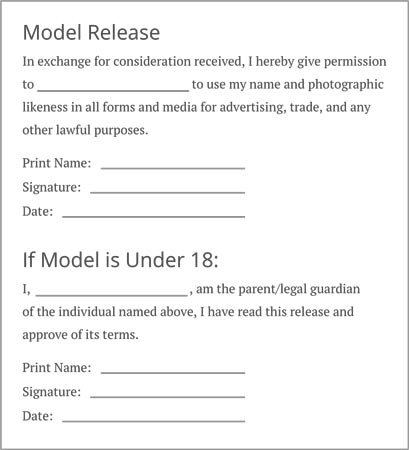
Note: NYIP’s attorney informs all readers that we accept no responsibility for any liabilities you may incur on any of your jobs. If ever you’re hired to work a more high-profile job for a larger client, our attorney additionally suggests that you consult legal counsel of your own to specifically ensure that that the Release Form you use for the job covers all the points that are applicable to the very specific role you were hired for.
Where Do Photographers Work?
When it comes to launching a professional photography career, the reality is that unlike other professions where you will most often interview and be hired for a full-time, salaried job within a company, most photographers work independently and own their own businesses. If you’re a nature and landscape photographer, your income could come in the form of selling stock images, or selling more high-priced shots to larger scale buyers to use for commercial purchases. If you’re a wedding or portrait photographer, the most popular route within the industry would be to set up your own local studio and book clients via independently executed advertising such as business cards, Facebook or word of mouth.
That being said, there are still a number of photographers within the industry who still work under the umbrella of a larger media or brand source, doing editorial and product shoots for existing companies. Currently, a number of NYIP graduates are employed as editorial and commercial contributors to the following publications:










What kind of photography jobs can you expect to get?
Generally, the career path of a photographer is a personal decision. While many professionals dream of being independent business owners, others are more comfortable working full-time at a larger company and prefer the stability of a salaried career.
How Do I Set Up a Photography Studio?
If you’re looking to start your own business and have chosen to work independently, one of the first things you’ll need to do is assemble a functional studio space. Depending on how much money you have to invest in this venture, you might not be able to afford all the bells and whistles seen in an extravagant, fully-equipped pro studio, but there are 4 key elements of a beginners’ studio that we highly recommend you invest in to get started.
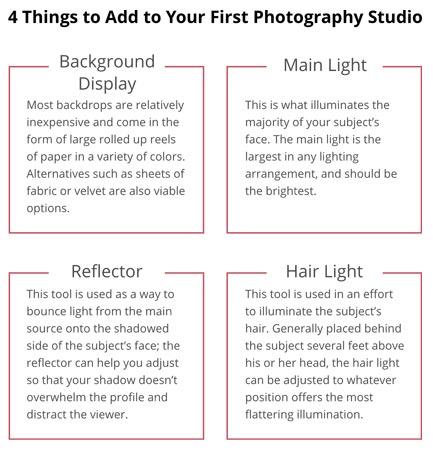
Background Display- Most backdrops are moderately low-cost and come in the form of large rolled up reels of paper available in an assortment of colors. If it’s easier for you to obtain in your area, a sheet of fabric could work as well- many photographers suggest velvet as their choice material option. Once you decide on and purchase the physical backdrop covering, you’ll then need support stands to drape it over in order to keep it in place.
Main Light- This is what illuminates the majority of your subject’s face in a studio setting. The main light is the largest in any lighting arrangement, and should therefore be the brightest.
Reflector- This tool is used as a way to bounce light from the main source (mentioned above) onto the shadowed side of the subject’s face. Although it’s important to maintain a vague shadow in an effort to accentuate the subject’s facial shape, this reflector can help you adjust so that your shadow doesn’t overwhelm the profile in an unflattering way.
Hair Light- This popular tool is used to illuminate your subject’s hair. Generally placed behind the subject several feet above his or her head, the hair light can be moved either slightly to one side of or directly above the model you’re working with, depending on which position offers the most flattering illumination for any given subject.
Are you prepared to set up your own photography studio?
Do I Need a Photography License?
Many photographers who plan to own and operate their own studio become concerned about the legal implications involved in this process, specifically the need or lack thereof to obtain some sort of professional commercial license in order to book and charge clients, or to use a home as a studio, etc.
If you’re considering converting your home into a studio or small business, all you need to do is make two phone calls before doing so in order to make sure you’re following all necessary legal protocol- one call to your state licensing board, and a second call to your local city hall.
In many places, your local government will require photographers to obtain a general permit in order to operate a business if they’ll be profiting off of it.
Even if you just plan to use your home as your studio, you still need to contact local government to make sure you’re doing everything by the books according to local business standards. Things like zoning regulations could cause issues when it comes to your ability to technically operate a business somewhere residential, etc. In some cities, your license is simply something your city officials want you to have in order to help them organize local business zones, and won’t even cost you anything. In other cities however, permits are sold at a small cost (mostly in an effort to raise money for local government).
But beyond your need for a license, you also need to make sure you’re prepared to pay the right taxes once you’ve technically become a small business operator. Because the government technically considers photos to be products, you might need to pay sales tax depending on where you live. To make sure you’re doing everything by the books, simply follow this link to search a sales tax number getting started.
Can you start working without a photography license?
How Do I Make a Photography Portfolio?
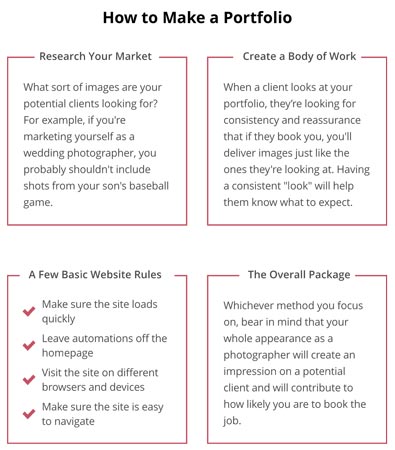
Unlike other industries where a resume is the most important thing you’ll use when applying for new jobs, in the field of photography, the portfolio is chiefly important. A comprehensive body of your best work, the portfolio is your opportunity to literally show your potential clients exactly what they can expect you to deliver if booked for a shoot. So what makes or breaks a perfect portfolio?
- Research Your Market
What sort of images are your potential clients looking for? For example, if you're marketing yourself as a wedding photographer, you probably shouldn't include shots from your son's baseball game. - Create a Body of Work
Be selective about which photos you show. When a client looks through your portfolio, they'll be looking for consistency and a reassurance that if they book you for a specific shoot, you'll deliver images just like the ones they're looking at. Having a consistent "look" will help them know what to expect. - A Few Basic Website Rules
Make sure the site loads quickly. Don't have excessive automations launching as soon as someone navigates to the home page. Check the site design on as many different browsers and devices as possible (what works on your big monitor at home on Firefox may look awful on a tablet running Safari). Make sure the site can be navigated easily (don't make the design so intricate that clients spend five minutes trying to find your contact information). - The Overall Package
Whichever method you focus on, bear in mind that your whole appearance as a photographer will create an impression on a potential client. Your behavior during a portfolio viewing, your responses to emails, your business cards and other business stationery — all of this will contribute to how likely you are to book the job.
Is your photography portfolio ready to be shared with clients?
How Much Do Photographers Get Paid?
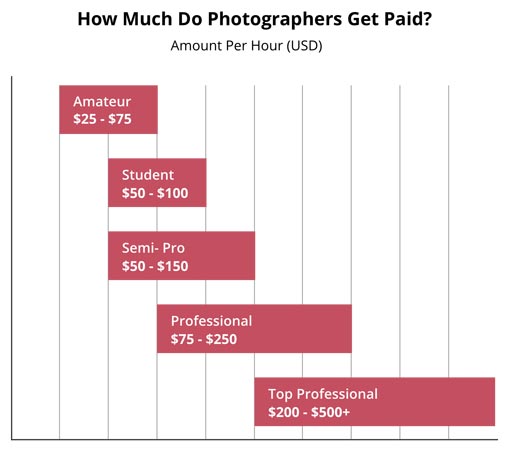
The amount of money you can make as a professional photographer depends on a number of relevant factors. Are you formally trained? How long have you been in business? Do you shoot weddings or commercial headshots? Below we outline what you can expect to be paid based on level of experience, but bear in mind that other factors such as niche industry will always also have an impact on that number:
Hobbyist: Free (or under $100). Plenty of photographers simply enjoy the craft and consider it something to do on the side, purely for fun. However, if you’re an active hobbyist and someone reaches out to you asking for a shoot, there’s nothing wrong with charging them for your time and effort somewhere within the $100 margin.
Amateur: $25 – $75 per hour. If you’re just getting started within the photography industry but have ambitions to launch your own studio someday, it’s important to charge your first clients for shoots. Many beginners, even though they’ve been formally trained, wind up working for free when they’re just getting started because they’re eager to build a portfolio. We advise against this- your work is valuable. If you’re truly new to the field and feel inappropriate charging more, stick within the $25- $75 range.
What is the average photographers’ salary?
Student: $50-100 per hour or $25-100 per image. As with all types of photography, the student rate varies, depending on your individual skill level and however many years of general experience you have under your belt. Some advanced students do (and should) charge on par with professionals.
Semi-Pro: $50–$150 per hour / $50-125 per image. These are likely formally trained photographers who already have some professional experience on the books. While they might not yet own their own studio, these are not beginners and therefore charge slightly more than students or recent grads.
Professional: $75-$250 per hour / $75-$250 per image. This photographer is an industry professional, has a highly regarded level of experience, and possibly owns his or her own established studio.
Top Professional: $200-$500+ per hour / $250-$1,500 per image. In any industry, there will always be an elite group of exclusive, more costly professionals. In the photography industry, some of the top pros in today's industry charge over $10,000 per day, or $1,500 per image.
If you’re interested in pursuing a serious, professional photography career, there are likely going to be tons of questions that pop up along your journey to that end goal. That’s where the mentorship at the New York Institute of Photography plays a key role in the professional lives of our students and grads. As a part of the NYIP student community, you’ll have 24-7 access to our internal network. From private, student only chat rooms and conversational forums to lifelong connections made with our mentors, the personal touch and global reach provided by NYIP is an invaluable aspect of the education we pride ourselves on providing.

